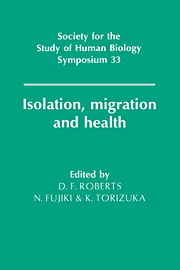Book contents
- Frontmatter
- Contents
- List of contributors
- Preface
- 1 The legacy of the IBP: Presidential Address
- 2 The distinction between primary and secondary isolates
- 3 Time trends in the break-up of isolates
- 4 Factors influencing the frequency of consanguineous marriages in Japan
- 5 Break-up of isolates
- 6 Isolates in India: their origin and characterisation
- 7 Consanguineous marriages and their genetical consequences in some Indian populations
- 8 Biomedical and immunogenetic variation in isolated populations in India
- 9 Genetic distance analyses in Israeli groups using classical markers and DNA polymorphisms in the β globin gene
- 10 Non-random distribution of Gm haplotypes in northern Siberia
- 11 Allele frequency estimation
- 12 Genetic affinities of human populations
- 13 Inherited neurological diseases in island isolates in southern Japan
- 14 Serological and virological evidence for human T-lymphotropic virus type I infection among the isolated Hagahai of Papua New Guinea
- 15 Analysis of genes associated with hypercholesterolaemia in the Japanese population
- 16 Migrant studies and their problems
- 17 Tokelau: migration and health in a small Polynesian society - a longitudinal study
- 18 Micromigrations of isolated Tuareg tribes of the Sahara Desert
- 19 Population structure in the eastern Adriatic: the influence of historical processes, migration patterns, isolation and ecological pressures, and their interaction
- 20 Diabetes and diabetic macroangiopathy in Japanese-Americans
- 21 Diabetes and westernisation in Japanese migrants
- 22 Environmental factors affecting ischemic heart disease
- Epilogue
- Index
7 - Consanguineous marriages and their genetical consequences in some Indian populations
Published online by Cambridge University Press: 05 March 2012
- Frontmatter
- Contents
- List of contributors
- Preface
- 1 The legacy of the IBP: Presidential Address
- 2 The distinction between primary and secondary isolates
- 3 Time trends in the break-up of isolates
- 4 Factors influencing the frequency of consanguineous marriages in Japan
- 5 Break-up of isolates
- 6 Isolates in India: their origin and characterisation
- 7 Consanguineous marriages and their genetical consequences in some Indian populations
- 8 Biomedical and immunogenetic variation in isolated populations in India
- 9 Genetic distance analyses in Israeli groups using classical markers and DNA polymorphisms in the β globin gene
- 10 Non-random distribution of Gm haplotypes in northern Siberia
- 11 Allele frequency estimation
- 12 Genetic affinities of human populations
- 13 Inherited neurological diseases in island isolates in southern Japan
- 14 Serological and virological evidence for human T-lymphotropic virus type I infection among the isolated Hagahai of Papua New Guinea
- 15 Analysis of genes associated with hypercholesterolaemia in the Japanese population
- 16 Migrant studies and their problems
- 17 Tokelau: migration and health in a small Polynesian society - a longitudinal study
- 18 Micromigrations of isolated Tuareg tribes of the Sahara Desert
- 19 Population structure in the eastern Adriatic: the influence of historical processes, migration patterns, isolation and ecological pressures, and their interaction
- 20 Diabetes and diabetic macroangiopathy in Japanese-Americans
- 21 Diabetes and westernisation in Japanese migrants
- 22 Environmental factors affecting ischemic heart disease
- Epilogue
- Index
Summary
Introduction
With the microevolutionary theory emerged the concept of a population as an isolated group of conspecific interbreeding individuals who share a gene pool. But human populations present a hierarchy of further isolations. Consanguinity in marriage, where it occurs, serves as an isolating mechanism at the lowest level. Such marriages have important implications for the health and wellbeing of the subsequent generation, and recognition of this led to systematic studies on the rates and patterns of marital consanguinity in different countries. The highest rates so far have been found in Japan, India, Israel and Brazil. But there is wide variability within each country and within local populations. The variability and the trends of consanguineous marriage in Indian populations are mainly determined by the marriage regulations and cultural traditions.
Marriage regulations
The first level of breeding isolation in Indian populations is determined by religious and sect affiliations and linguistic-cultural diversities and traditions. About 75% of the people make up the traditional Hindu society with its network of varnas and endogamous jatis, about 8% belong to more isolated and relatively tradition-bound groups called the scheduled tribes near forests and hills, about 13% belong to Muslim communities, and the rest to Sikh, Christian, Buddhist, Jain, Parsee and Jewish. All of them are distributed over the different provinces and states, with different linguistic or other traditions. These populations originated mainly from indigenous peoples (Hindus) and are divided and subdivided into endogamous occupational, local and cultural units (Mukherjee, 1971).
- Type
- Chapter
- Information
- Isolation, Migration and Health , pp. 63 - 74Publisher: Cambridge University PressPrint publication year: 1992
- 6
- Cited by

